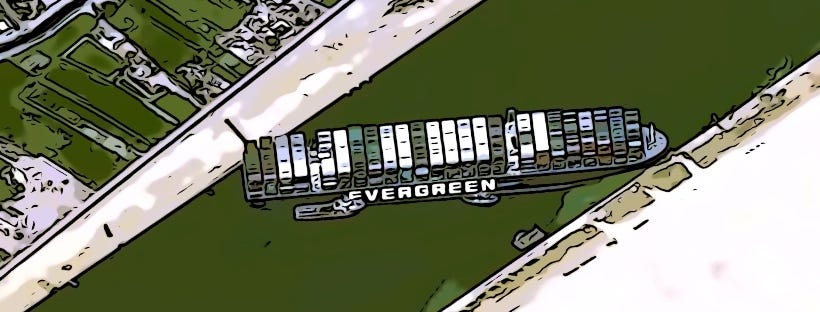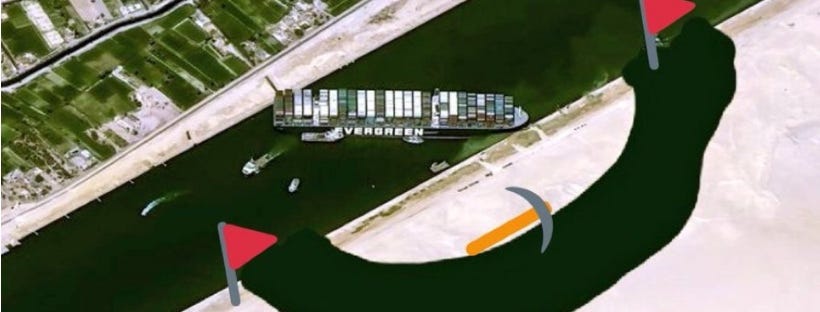Did Cleopatra ever sail on the Suez Canal? It is quite possible, although I am not talking about the modern Suez Canal. Before you know it, we will see memes of a 3rd century B.C. Ptolemaic barge blocking the canal. More on those Suez memes later, let's first dive into history.
Historians believe there must have been a connection between the Red Sea and the Nile; from there, one could sail onwards to the Mediterranean. The concept of such a canal was already ancient history in Cleopatra's time. It is likely that more than 1500 years earlier, during the rule of Pharaoh Senusret III, a connection from the Red Sea towards the Nile existed. It was a much more modest connection than the present one that allows for ships by the size of the Ever Given; a cargo carrier that in vertical position would rank in the top-40 skyscrapers in the world.
The first water connection was an irrigation canal that was only navigable during the flood season, and it led to a dry river valley east of the Nile river. It was a good start, and some 1200 years later, the work continued under Necho II's leadership. It was the Persian conqueror Darius who completed the canal. In the days of Cleopatra, it is likely that the channel was accumulating silt and became less accessible.
Ferdinand De Lesseps
Fast forward in history, and Napoleon Bonaparte conquered Egypt. His engineers were the first to design a modern canal. However, they advised against the project because they mistakenly believed that the Red Sea was ten meters higher than the Mediterranean, and this project would end in a flooding disaster. By the mid-nineteenth century, it became clear that there was no such risk. A former diplomat from France, Ferdinand de Lesseps, revived the millennia-old dream of connecting the Red Sea and the Mediterranean. The British government, and the British press, were alarmed by his plans and his initiative to establish the Suez Canal Company. At the height of these tensions, De Lesseps even challenged Robert Stephenson for a duel. If that name is still familiar, he is the locomotives engineer and George Stephenson's son, 'the father of railways.'
A message from Darius
A couple of years later, the son of Ferdinand de Lesseps, Charles, discovered a stele of pink granite, some 30 kilometers from Suez. It was erected some 2500 years earlier by Darius, the Persian Conqueror. He was the one that had finalized the first connection between the Red Sea and the Mediterranean, the waterway for which the first works had started more than a thousand years before his time. Isn't history beautiful?
The surviving inscription of the rightly proud Darius reads:
"King Darius says: I am a Persian, setting out from Persia. I conquered Egypt. I ordered to dig this canal from the river that is called Nile and flows in Egypt, to the sea that begins in Persia. Therefore, when this canal had been dug as I had ordered, ships went from Egypt through this canal to Persia, as I had intended."
Ismael Pasha
While his son connected back into history with famous canal builders over the millennia, Ferdinand de Lesseps was more focused on the future. He had to modernize his approach because the Egyptian ruler Ismail Pasha abruptly banned forced labor in the slowly progressing project. Faced with this situation, De Lesseps chose a radically different path and brought in the high-tech of his age; he introduced hundreds of steam engines that speeded up the work.
By 1869 the canal was opened with lots of festivities and in the presence of royalty. The most prominent was the French Empress Eugenie, consort of Napoleon III. Other guests included the Sultan of Turkey, the Austro-Hungarian Emperor Franz Joseph, the Crown Prince of Prussia, and the Crown Prince of the Netherlands. Luxurious temporary structures were erected; for Eugenie, a replica was provided of her private apartments in the Tuileries Palace in Paris.
By that time, De Lesseps could have attached his name to another famous project. Frédéric-Auguste Bartholdi approached him with a proposal to erect a 30-meter high statue of a woman carrying a torch. It would indicate to all ships the entrance to the canal. Bartholdi didn't give up when De Lesseps told him that he was not interested. He made a few changes to his design, inspired by the ancient Colossus of Rhodes, and searched successfully for other interested parties. Many of you will have seen his colossal creation where it still stands in New York City.
Failure in Panama
The official opening of the Suez canal was De Lesseps's moment of fame. Some years later, we find him back in our history books in Central America, trying to build another passage. This early effort for a Panama Canal was a complete failure, cost many lives, and financially collapsed in 1889. Ferdinand de Lesseps died five years later, and he was buried in the Père Lachaise cemetery in Paris. The same year, the impressionist painter Gustave Caillebotte was also buried at this famous Parisian cemetery. Like De Lesseps, he was fascinated by technological progress. I remember reading that Monet's Saint-Lazare Station was one of Caillebotte's favorite paintings, full of steam-engine locomotives, quite likely built according to Stephenson's designs.
The Suez Crisis of 1956 put the canal again on the front pages, as did the Six-Day War between Israel and Egypt in 1967. For fifteen freighters, it was the start of eight years of waiting until they could finally sail out of the canal. At that moment, only two of them were still seaworthy.
I remember my history teacher who had the reputation to always start at genesis. I may have skipped the first 2000 years, but he would have appreciated describing 4000 years of canal history in one newsletter. I may have omitted some details here and there and took some side-steps in historical connections, but I hope you liked reading another Suez story now that the canal gets so much attention.
I promised some memes when I started writing. Enjoy!
Notes:
https://en.wikipedia.org/wiki/Suez_Crisis#:~:text=It%20later%20became%20clear%20that,to%20plan%20out%20the%20invasion.&text=Historians%20conclude%20the%20crisis%20%22signified,October%201956%20until%20March%201957.
https://www.fr24news.com/a/2021/03/suez-canal-a-brief-history-of-the-egyptian-trade-route-and-the-ever-given-stranded-in-its-waters.html
https://ghorbany.com/inspiration/the-canal-that-darius-built
https://www.history.com/news/9-fascinating-facts-about-the-suez-canal
https://en.wikipedia.org/wiki/Suez_Canal










The Suez Canal plays a surprising role in Canadian political history. In 1956, a diplomat, Lester B. Pearson was central in defusing an international conflict by convincing the UN to establish their first "Peacekeeping Force". Eventually this led to his Nobel Peace Prize and to the job of Prime Minister of Canada. Of course the details are a lot messier than our national memory of the events. A good summary (and much more detail) is available here: http://www.suezcrisis.ca/summary.html
Good morning Alexander it's a sunny day today. I enjoyed stepping into your Suez Canal time capsule this morning and learning how the canal came into existence. Ismael Pasha stands out for me because he ended the forced labor, by changing to better technics; The Steam Engines that already had been in use. Technology came to the rescue in earlier days. Now lets see (and wait) how the Suez Canal's sticky problem is going to be solved. It's a inconvenience of truly global proportion. Bravo, a wonderful read.